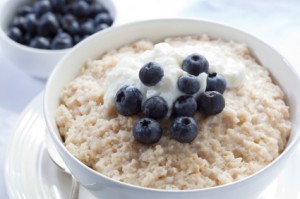Fibre Is Key to Preventing Belly Fat and Living Longer
Getting your daily requirements for dietary fiber may be the answer to helping
you stay free of belly fat that is linked to chronic disease. Two new studies
published this year show a connection between increased soluble fiber intake and
less accumulation of belly fat, as well as an association between increased total
fiber intake and longer life.
In one study, published in the online journal, Obesity, by researchers at Wake
Forest University School of Medicine, results showed that for every 10 gram
increase in soluble fiber there was a 3.7 percent decrease in visceral adipose
tissue (belly fat). The study explored the effects of lifestyle factors—diet, physical
activity and smoking—on fat that builds around the midsection. Over the course
of five years, the researchers collected data from 1,114 African-American and
Hispanic men and women. Of the factors observed, the two that reduced belly
fat the most were engaging in vigorous physical activity and increasing soluble
fiber intake from beans, vegetables, and fruits.
So why should we be concerned about belly fat anyway? Besides from not
letting you look your best in a swimsuit, fat around the midsection builds up
fatty deposits around your internal organs and has been shown to lead to chronic
diseases such as heart disease, diabetes and high blood pressure. The other type
of fat that accumulates in the body, subcutaneous fat, or fat that deposits just
under the skin, is not so much the health concern that belly fat is. As more of
the population is struggling with their weight and finding themselves with that
“ring” of fat around the middle, researchers from this study conclude that
“increasing the intake of dietary fiber may be a possible approach for prevention.”
Also building the case for increasing fiber in your diet is a study by researchers
from the U.S. National Cancer Institute that found diets higher in fiber,
especially fiber from grains, significantly reduce the chance of dying from
cardiovascular, respiratory and infectious diseases. This study followed over
388,000 American men and women over the course of nine years and found
that, overall, people with the highest intakes of fiber—an average of 25 to 30
grams a day—were 22 percent less likely to die from any natural cause than
those consuming just 10 to 13 grams.
Now that we know how much fiber we need (face it, we know most of us
aren’t getting enough) and that research is backing up the reasons to get
more in our diet, what exactly is fiber anyway? Fiber is a non-digestible
carbohydrate that’s present in all plant foods including grains, legumes,
nuts, seeds, fruits and vegetables. There are several ways to classify fiber,
such as by its origin or whether or not it will dissolve in water. For example,
fiber found in grains is called cereal fibers and fiber that’s dissolvable in water
is referred to as soluble fiber while insoluble fiber does not dissolve in water.
Usually there is a mixture of both in fiber-containing foods, and both provide
you with various health benefits.
Soluble fiber has long been known as a health-promoting powerhouse because
it helps lower blood cholesterol levels, helps improve blood glucose levels,
and helps form soft stools. Insoluble fiber supports regular bowel movements.
Previous studies have implied that a combination of dietary fiber of both types
might help reduce the risk of heart disease, diabetes, and some cancers. The
current U.S. dietary guidelines recommend consuming 14 grams of fiber for
every 1,000 calories consumed, or 28 grams per day for women and 38 grams
per day for men. These recommendations don’t seem to be getting through
though to many people—recent estimates indicate that, on average,
US adults are getting about half the dietary fiber they need. To give you
an idea of what you might need to meet the requirements, here’s a list of
some typical foods and their fiber levels:
Oatmeal - 1 cup - 4g of dietary fibre
Whole Wheat Bread - 1 slice - 2g
Apple, raw with skin - 1 medium - 3.7g
Orange - 1 medium - 3.1g
Blueberries - 1/2 cup - 2g
Black Beans - 1/2 cup - 7.5g
Broccoli - 1/2 cup - 2.3g
Green Peas - 1/2 cup - 4.4 g
What may be apparent here is that it takes a lot of good, healthy food to get your
recommended amount of fiber in every day. It’s understandable that many people
don’t meet their recommendations given the typical American diet of
overly-processed, highly-refined, and fiber-less food. Fact is, food manufacturers
have long focused on leaving fiber out of their products because of its
interference with flavor. Indeed, when people think of high-fiber products,
it’s likely that images pop up of products with bland, cardboard-like flavors.
Isagenix seeks to change the way people think of high-fiber products. For example,
Isagenix SlimCakes are a cookie-like product so delicious it’s hard to believe they
provide 5 grams of fiber each and FiberSnacks!, providing 6 grams of fiber each,
could easily compete with any candy bar in terms of flavor. Another product
Isagenix produces is FiberPro, a completely flavorless powder that will add
5 grams of fiber by the scoop to any beverage or shake. With choices like
these, getting enough fiber is a cinch!
Bottom line? However way you obtain high-fiber foods in your diet, soluble or
insoluble, it is good for your heart and blood sugar, helps cut down on belly
fat, and helps you live longer. Be sure to add fiber to your diet gradually
though, and drink plenty of water to avoid gas, bloating and constipation.
Other than that, time to load up!

No comments:
Post a Comment